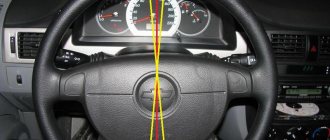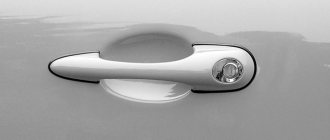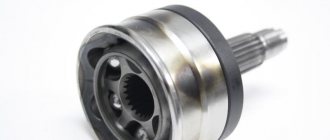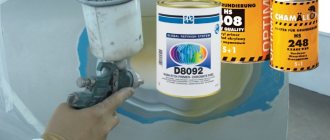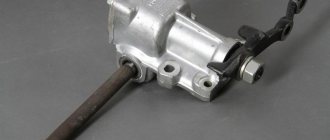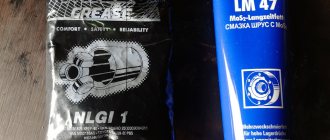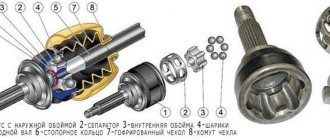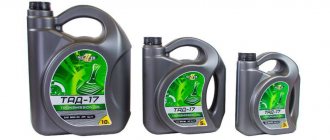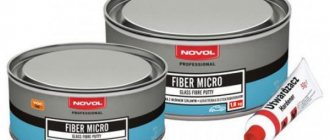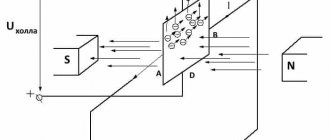Lubrication for the steering rack is necessary to ensure the normal operation of this unit and extend its service life. The lubricant is used for all three types of steering racks - without power steering, with hydraulic power steering (power steering) and electric power steering (EPS). To lubricate the steering mechanism, lithium greases are usually used, ranging from the usual “Litol” to more expensive, special lubricants.
Specialized lubricants for the shaft and under the steering rack boot work better and last longer. However, their significant drawback is their high price. See a review of the best steering rack lubricants, based on reviews found on the Internet and the technical characteristics of the products themselves. He will help you decide on the choice of lubricant.
| Grease name | Brief description and characteristics | Package volume, ml/mg | Price of one package as of summer 2022, Russian rubles |
| "Litol 24" | Universal multi-purpose lithium grease, widely used in various automotive components. Perfectly suited for installation in the steering rack. An additional advantage is availability in stores and low price. One of the best options. | 100 | 60 |
| "Fiol-1" | An analogue of “Litol-24” is a universal lithium grease, perfect for placing under the boot or on the steering rack shaft. Softer than Litol. The manufacturer recommends installing it in the racks of VAZ cars. It has a low price. | 800 | 230 |
| Molykote EM-30L | Synthetic grease with a wide temperature range. Perfect for lubricating the steering rack shaft, as well as for placing it in the boots. Another feature is that the manufacturer clearly indicates that it can be used to lubricate the steering rack worm with electric power steering. The disadvantage is the very high price. | 1000 | 8800 |
| EFELE MG-213 | Universal lithium grease with a wide temperature range. Please note that it can only be used in metal-to-metal friction pairs. It is not advisable to use it with rubber and plastic parts. | 400 | 300 |
| Liqui Moly Thermoflex Spezialfett | Lithium based grease. It has excellent characteristics and is safe for rubber, plastic, and elastomer. Can be used to carry out repair work at home. The disadvantage is the high price. | 370 | 1540 |
When to use steering rack lubricant
Initially, manufacturers always put a certain amount of lubricant on the shaft and under the steering rack boots. However, over time, as it becomes contaminated and thickened, the factory lubricant gradually loses its properties and becomes unusable. Therefore, the car owner needs to periodically change the steering rack lubricant.
There are a number of signs, if at least one of them is present, you need to inspect the condition of the steering rack and, if necessary, replace the lubricant. In parallel with this, other work is possible, for example, replacing rubber sealing rings. So, these signs include:
- Creaking sound when turning the steering wheel. In this case, a hum or extraneous sounds come from the rack, usually on the left side of the car.
- Racks that are not equipped with power steering have a tighter turn, that is, it becomes more difficult to turn the steering wheel.
- When driving over uneven surfaces, the rack also begins to make a creaking and/or hum. However, in this case, additional diagnostics need to be done, since the cause may not be in the rack.
If the car owner encounters at least one of the symptoms listed above, then it is necessary to perform additional diagnostic steps, including checking for the presence of lubricant in the steering rack.
Alarming symptoms
No matter how often you change the steering rack lubricant, unfortunately, it cannot extend the life of all parts of the mechanism indefinitely. Therefore, if the following factors are detected, it is recommended to immediately stop using the vehicle and contact a service center.
- Increased steering play.
- Turning the steering wheel requires more effort than before.
- Traces of steering rack lubricant leakage were found.
Knocking and extraneous sounds in the steering mechanism. They usually appear when making a sharp turn or turning the steering wheel, or when hitting protruding parts of the road. To make sure that the cause is in the rack, you need to:
- place the car on a flat surface;
- get out of the car and open the hood;
- unscrew the wheel until it stops in both directions;
- Listen carefully to where the sound comes from when you turn the steering wheel sharply.
Timely diagnostics will protect your car from possible future serious breakdowns and sudden expenses.
All lubricants have a different set of characteristics (composition, properties, cost). And if the question arises about which lubricant to use, then it is better to give preference to lithium. The best on the market are considered to be Litol-24, Fiol, Tsiatim and Severol. They are moisture-resistant, have a long processing interval, reduce vibration, do not wash off, and contain antioxidant and wear-resistant additives. Steering rack lubricant must have a high load-bearing capacity to avoid extrusion.
If a low-quality lubricant is used in operation, which does not meet the listed qualities, then this will soon lead to wear of individual parts and assemblies of the steering mechanism. It is important to always listen to your car, pay attention to warning signs in time, carefully choose which lubricant to lubricate, lubricate the steering rack in a timely manner and be responsible in choosing a lubricant.
What kind of lubricant to lubricate the steering rack
Greases are usually used to lubricate steering racks. In fact, they can be divided by the composition on which they are based, and therefore by price range. In general, steering rack lubricants can be divided into the following types:
- Lithium greases. A classic example is the famous “Litol-24”, which is ubiquitous in automotive mechanisms, including it is often used to process the steering rack. Can operate over a wide temperature range. Its only drawback is its gradual liquefaction, which causes it to gradually spread out.
- Calcium or graphite (solidol). This is the class of the cheapest lubricants with average performance characteristics. Well suited for cars belonging to the budget class.
- Complex calcium lubricant. It tolerates low temperatures well, but absorbs moisture, and at the same time changes its consistency and properties.
- Sodium and calcium-sodium. Such lubricants do not withstand moisture well, although they can work at high temperatures.
- Barium and hydrocarbons. These are one of the most expensive lubricants, but have high performance characteristics.
- Copper. They withstand high and low temperatures well, but absorb moisture. They are also quite expensive.
As practice shows, it is quite possible to use inexpensive lithium greases , thereby saving the car owner money. Their characteristics are quite sufficient to ensure normal operation of the steering racks.
General requirements for lubricants
To correctly answer the question of which steering rack lubricant is best, you need to understand the requirements that an ideal candidate must meet. So, it is necessary to take into account:
- Operating temperature range. This is especially true for its lower limit, since in winter the lubricant should not freeze, but in summer, even in the hottest weather, the steering mechanism is unlikely to warm up to high temperatures (the temperature is unlikely to even reach +100°C).
- Constant viscosity at the level of a paste product. Moreover, this is relevant for the operation of the lubricant in all temperature ranges at which the car is operated.
- High constant level of adhesion, which practically does not change when operating conditions change. This also applies to both the temperature regime and the relative humidity of the surrounding air.
- Protection of metal surfaces from corrosion. The steering housing cannot always ensure tightness, so in most cases moisture and dirt get into it, which, as is known, have a detrimental effect on metal, including the so-called stainless steel.
- Chemical neutrality. In particular, the lubricant should not harm parts made of various metals - steel, copper, aluminum, plastic, rubber. This is especially true for a steering rack with power steering. It has a lot of rubber seals that should work properly and withstand the operating pressure. This is less relevant for cars with electric power steering.
- Restorative abilities. Steering rack lubrication should protect the working surfaces of parts from excessive wear and, if possible, restore them. This is usually achieved by using modern additives such as metal conditioner or similar compounds.
- Zero hygroscopicity. Ideally, the lubricant should not absorb water at all.
All of the above properties are fully satisfied by lithium greases. As for electric steering racks, the use of such means is safe for them, since they are dielectrics. Accordingly, they cannot damage the engine or other elements of the amplifier's electrical system.
Causes of EUR failure
Why does the electric power steering on the Lada Kalina not work, turns off and refuses to work, what are the signs of a steering wheel with power steering knocking, jamming, biting or squeaking? To repair the system yourself, you need to know how diagnostics are carried out and what causes precede the breakdown. Most often, the failure of the amplifier is caused by a breakdown of the unit itself and the amplifier fails. Problems of this type are resolved by thoroughly checking the system to identify the exact problem.
As practice shows, often the inoperability of the electric amplifier (failure) is associated with a breakdown of the speed controller.
Consequences:
- the steering wheel is jammed,
- jams
- becomes tight
- and others
Because the speed controller sensor ensures activation and deactivation of the electric power steering under different driving modes. The amplifier on Kalina works if the car is moving at low speed. When the speed begins to increase, the booster automatically turns off, allowing for safer machine control when driving at high speeds.
So, briefly about the reasons for the inoperability of the EUR:
- The speed controller has failed or the control unit does not receive or disappears a signal from it. In this case, the reason may lie in either a breakdown of the sensor, damaged wiring, or poor contact of the controller with the on-board network.
- The voltage in the vehicle's electrical network has decreased. The reasons can be different, ranging from a dead battery and an inoperative generator to the use of inappropriate electrical equipment in the car.
- The permissible crankshaft speed has been exceeded.
- Incorrect operation or failure of the control module. Depending on the cause, the control unit may need to be repaired; more detailed diagnostics need to be done.
How to lubricate a steering rack
Once the choice has been made in favor of one or another lubricant for the rack, it must be remembered that it is also necessary to directly lubricate this unit correctly. It is important to separate racks with power steering and racks without power steering, as well as with power steering. The fact is that in hydraulic steering racks there is no need to lubricate their drive shaft, since it is lubricated naturally thanks to the power steering fluid, in particular, the point of contact between the gear and rack is lubricated. But the shafts of conventional racks and racks with electric power steering need lubrication.
To change the lubricant on the shaft, the steering rack does not need to be dismantled. The main thing is to find the adjusting mechanism, where, in fact, the new lubricant is added. Where it is located on a specific car model - you need to inquire in the relevant technical documentation. The second important point is that it is advisable to thoroughly remove the old lubricant so that it does not mix with the newly applied product. However, to do this you will need to dismantle the rail. But in most cases, new grease on the shaft is simply added to the old one.
Dismantling and disassembling the electric amplifier
Before removing the amplifier, you need to remove all the steering column switches. Remove the steering rack cover and dismantle the devices, remembering to disconnect the connectors from the power supply.
How to remove the EUR with your own hands:
- After removing the switches, you will need to dismantle the lower cross member of the dashboard. To do this, you need to press the fasteners that secure the connector with wires, and then disconnect the wiring from the control module. Once these steps are completed, you can disconnect the connector from the switches.
- The system bracket is secured with nuts; you will need to unscrew them with a wrench.
- After this, the steering rack will need to be carefully lowered down. To do this, you will need to find the bolt that secures the driveshaft to the booster shaft. This bolt must be unscrewed, but when unscrewing, you will need to fix the nut, this will prevent it from turning. When the bolt is removed, the fastening will need to be loosened, after which the intermediate shaft will be carefully removed. At this stage, we recommend marking the position of the shaft and gears; you can use a marker for this. This step is very important because doing it will prevent possible installation problems in the future. If the marks on the shafts do not match, this may cause problems with the amplifier. When dismantling, be careful not to damage the wiring, as this will also lead to the inoperability of the ESD.
- When the unit is dismantled, it will need to be disassembled and the failed elements replaced. Further editing is done in reverse order (the author of the video is Murzik Bely).
How to lubricate the steering rack?
A wide variety of lubricants are sold in stores. But how to choose the one that is most suitable.
All lubricants differ in their base, which is determined by the thickener. Based on this property, the following types of lubricants are divided:
- calcium and graphite (solidol). This type of lubricant has performance characteristics that satisfy many car enthusiasts and a relatively low price. But at the same time, solid oil does not tolerate low temperatures;
- complex calcium. This lubricant is more resistant to low temperatures, but absorbs moisture and is prone to heat strengthening;
- sodium and sodium-calcium. Unfortunately, this type of lubricant is not at all resistant to moisture, so it is not so common. But it can withstand a high temperature range;
- lithium It is gaining popularity due to lithol, which is used on all parts and components of the car and has a low cost on the market. The only drawback of the lubricant is its gradual squeezing out of parts as a result of liquefaction. It is this material that is best given preference when processing the steering rack;
- barium and hydrocarbon. They are resistant to water, have good preservation properties, but contain a large amount of soap, are difficult to produce on an industrial scale and do not withstand low temperatures;
- copper. Withstands extremely high temperatures and operates under high pressure, often used in tire fitting work. But it does not withstand moisture well.
How to lubricate the steering rack?
It is impossible to change the oil or lubricant of the rack without dismantling it. And for this it is absolutely not necessary to send the car to a service center. Before applying new lubricant to mechanism parts, you must first get rid of the old one by first disassembling the part. You need to prepare the lubricant and a couple of clamps in advance, and then get to work. It is important that the lubricant is also suitable for the materials from which the anthers are made.
- First you need to lift the left side of the car, turn the steering wheel to the right and remove the wheel.
- Then clean the surrounding area a little.
- Loosen the reusable small tie on the right boot and cut the large inner disposable tie.
- By sliding the corrugation up the shaft, you can see the presence of lubricant.
- Next, lubricate, sparing no material, the rail and the boot itself from the inside. Turn the steering wheel all the way a couple of times and add more lubricant. Reinstall using a pre-purchased clamp.
- Carry out the same operation on the left side.
The lubricant change procedure should be repeated regularly so that the steering mechanism serves you for many years. To process parts, use only lubricants and oils recommended by the manufacturer.
The main condition for the longevity and reliability of the rack is its tightness, since in the event of a violation of the protective seals, neither the quality nor the properties of the lubricant will play a special role in the operation of the unit.
It is very important to fill the rack with lubricant to the very end, this will ensure precise control and a long service life of the mechanism and the lubricant itself. It is also worth filling the substance into the anthers, at the same time checking their integrity. If you find the slightest cracks or tears in them, you need to urgently replace them. Otherwise, the steering rack will “leak”. After all, the direct purpose of the boots is to protect the steering mechanism from dirt, dust, moisture and lubricant leakage from the crankcase. Such damage can lead to rapid wear and failure of the mechanisms.
Even on a new car, it is recommended to check to ensure that the required amount of the substance is present.
When the question is what is the best way to lubricate the steering rack, it is very important to pay attention to resistance to temperature changes. A frozen lubricant will not have any positive consequences.
Steering rack repair is not a rewarding task. If you replace some of its components, the effect will be short-lived. Therefore, the best solution when the mechanism wears out is to install a completely new steering rack.
Comments
Guests cannot leave comments on the site, please log in.
Products for LADA at the best price
A selection of accessories for LADA from AliExpress
» Car systems » Steering » What lubricant to use for the steering rack
The steering mechanism is one of the main elements of vehicles, which bears considerable responsibility for the life, health and safety of the driver. Steering rack lubrication requires special attention, without which it is impossible to transmit steering rotation to the wheels. Indeed, during the process of friction, the metal parts of the car are constantly exposed to heat and wear out to the point of being unusable. The processing of parts makes it easier to turn the steering wheel, and if there is an electric or hydraulic booster, it extends their service life.
A steering rack is a device that allows you to control the synchronous operation of the front wheels using the steering wheel.
- VAZ 2114: replacing the steering rack - signs of failure, choosing a new part
